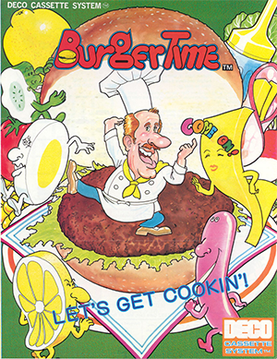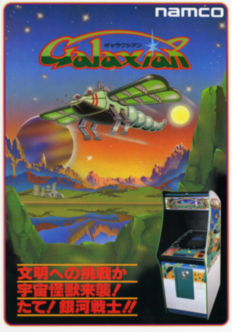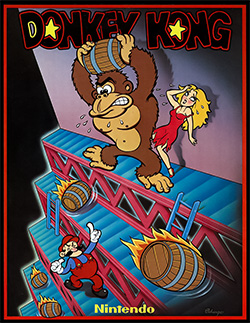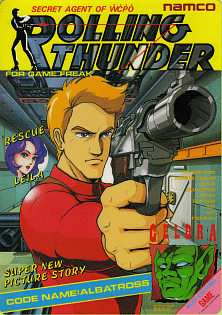Notable releases
Games
Arcade
- January – Namco releases Xevious .
- March – Sega releases Astron Belt in the Japanese market, the second laserdisc video game. It uses pre-rendered, computer-animated film footage as backdrops, overlaid with sprite graphics.
- May – Atari releases Star Wars , a color vector graphics game based on the popular film franchise. [51]
- Konami releases Gyruss in Japan. Centuri distributes the game in North America. [52]
- June 14 – Nintendo releases Mario Bros. , which features the first appearance of Mario's brother, Luigi.
- June 19 – Cinematronics releases Advanced Microcomputer Systems's Dragon's Lair , [53] the third laserdisc video game, and the first in the American market.
- June – Data East releases Bega's Battle , a laserdisc video game. [54] It uses anime FMV cut scenes to develop a story between the game's shooting stages, which would later become the standard approach to video game storytelling. [55]
- August – Sega releases Astron Belt in Europe, as the first laserdisc game in the region. [56]
- September – Konami releases Track & Field .
- November – Sega releases Astron Belt in the United States. [57]
- December – Namco releases Pole Position II , adding three additional tracks.
- Atari releases the trackball-controlled Crystal Castles .
- Bally/Midway releases Spy Hunter . [58] They also release Jr. Pac-Man and quiz game Professor Pac-Man without Namco's authorization, and the latter is an immediate flop.
- Nintendo releases Punch-Out!! in Japan.
- Williams releases Blaster , which was originally programmed on an Atari 8-bit computer.
- Parker Brothers releases James Bond 007 .
Personal computer
- June – Yuji Horii releases The Portopia Serial Murder Case for the NEC PC-6001 in Japan. It is an influential adventure game that lays the foundations for the visual novel genre. [59]
- July 8 – Infocom releases Planetfall , which becomes one of their top sellers.
- August 23 – Origin Systems publishes Ultima III: Exodus , one of the first role-playing video games to use tactical, turn-based combat. It is released for the Apple II, Atari 8-bit computers, Commodore 64, and IBM PC. [48]
- ASCII releases Bokosuka Wars for the Sharp X1 in Japan. It is a precursor to the tactical role-playing game [60] and real-time strategy [61] genres.
- Koei releases Nobunaga's Ambition for Japanese computers. Its combination of role-playing, turn-based grand strategy and management simulation elements sets a standard for the historical simulation and strategy RPG genres. [62]
- Electronic Arts publishes its first five titles: Hard Hat Mack , Pinball Construction Set , Archon: The Light and the Dark , M.U.L.E. , and Worms? . [63]
- Bug-Byte releases Matthew Smith's Manic Miner , a platform game, for the ZX Spectrum. [64]
- Ultimate Play the Game, later known as Rare, releases its first video games, Jetpac and Atic Atac , for the ZX Spectrum. [65]
- Hudson Soft releases Bomberman for the MSX and FM-7.
- Psion releases Chequered Flag , the first driving game published for the ZX Spectrum, [66] one of the first computer car simulators, and the first driving game with selectable cars. [67]
- The 4-player simultaneous Dandy is released for the Atari 8-bit computers. It directly inspires 1985's Gauntlet arcade game.
- Muse Software releases a port of Castle Wolfenstein for the MS-DOS.
Console
- December 12 – Nintendo publishes Donkey Kong Jr. Math , for the Famicom.
- Mattel Electronics publishes World Series Baseball for the Intellivision, one of the first video games to use multiple camera angles. [68]
- Activision's final big year of Atari 2600 releases includes Enduro , Decathlon , Keystone Kapers , Robot Tank , and Space Shuttle: A Journey into Space .
Hardware
Arcade
- May – Sega Laserdisc hardware releases, as the first laserdisc video game hardware.
- July – Sega System 1 releases, with Star Jacker game. [69] Its graphics chips are later used in the Sega System 16 and Sega Space Harrier boards.
- December – Namco Libble Rabble (System 16 Universal) releases, as Namco's second arcade system board to use a 16-bit microprocessor.
Console

- July 15 – Sega releases the SG-1000 console in Japan, [70] on the same day as the Famicom.
- July 15 – Nintendo releases the Family Computer (Famicom) console in Japan. Shortly after its release, complaints begin to surface about rampant system instability, prompting Nintendo to issue a product recall and to rerelease the machine with a new motherboard. [43] It would later be released worldwide as the Nintendo Entertainment System (NES).
- October – Casio launches the Casio PV-1000 in Japan. It does not remain on the market for long.
- October – Gakken launches the Compact Vision TV Boy in Japan. It's the last second generation console released. It was expensive and obsolete at launch, being discontinued shortly after.
- GameLine, a combination modem and dialup game distribution service for the Atari 2600, is announced but never ships.
Personal computer
- January – Apple Computer releases the Apple IIe, which becomes their most popular 8-bit machine.
- June 16 – Microsoft Japan releases MSX, an early standardized home computer architecture.
- March – Atari releases the poorly received 1200XL computer. Late in the year it and the rest of the Atari 8-bit computer series are replaced by the 600XL and 800XL.
- June – Mattel Electronics releases the Aquarius home computer, originally designed by Radofin Electronics Far East. [71]
- October – Coleco releases the Adam home computer. [72] It is only on the market for 15 months.
- October – Mattel discontinues the Aquarius.
- Acorn Computers release the Acorn Electron, a cut down version of their BBC Micro to compete in the under £200 home computer market. Problems in manufacture see only 1 in 8 presales being delivered for the Christmas market.
- Sega releases the SC-3000, a personal computer version of the SG-1000 console, in Japan. [70]












